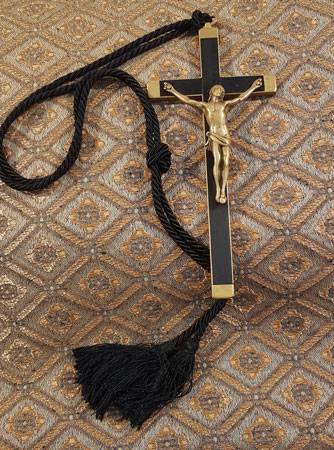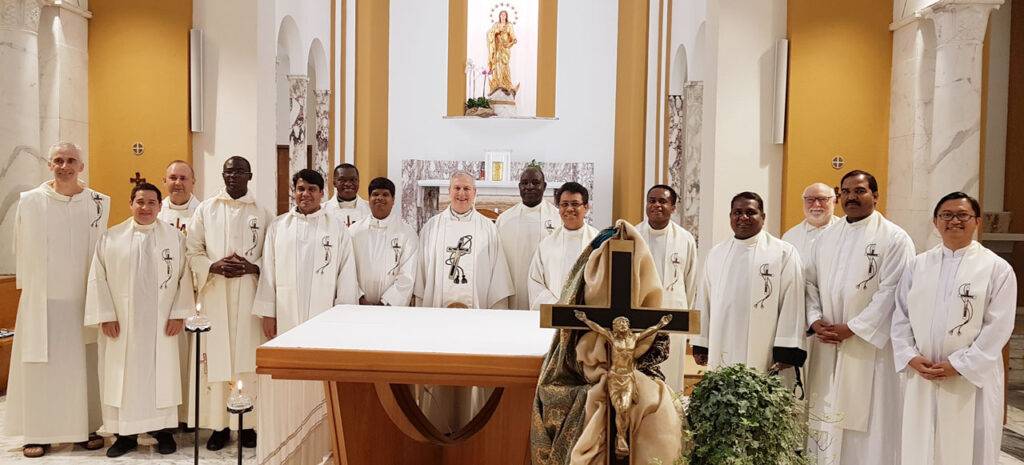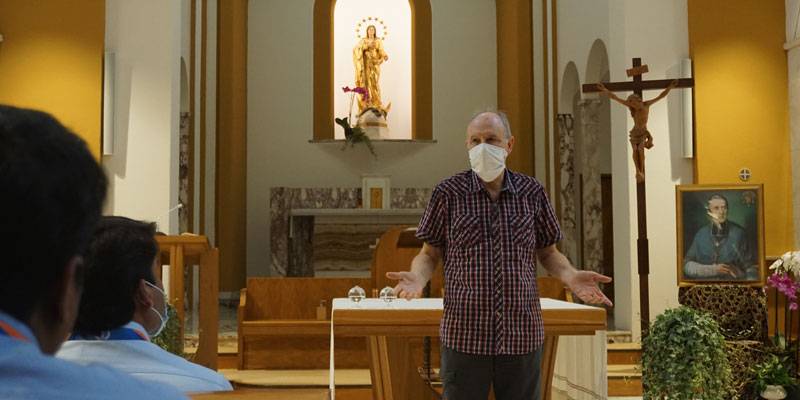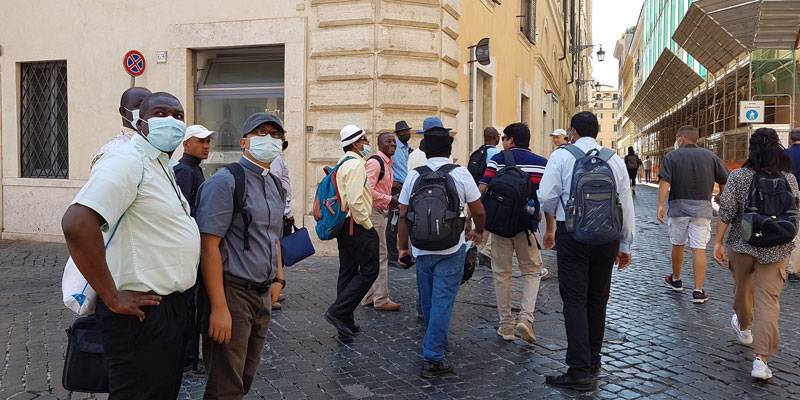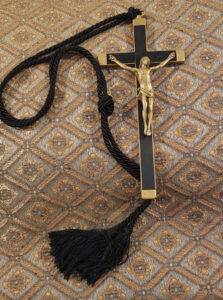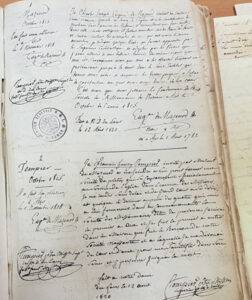Seven Days on the Oblate Charism
On July 15, and then on July 18-23, 2021, Fr. Fabio Ciardi OMI invited the participants to the Workshop for Post-Novitiate Formators, to explore the Charism of Saint Eugene de Mazenod. “I will not give you fish, but rather I will teach you how to fish”. That’s how he introduced his session with us. Let me share some of the points that impressed me in those seven days of encounter with Fabio Ciardi.
A Beautiful Retreat
For me personally, the seven days with Fabio Ciardi were more a time of retreat than simply an intellectual encounter. It was an opportunity to realize more about my identity as an Oblate by getting to know deeper the life events, concerns, aspirations, and desires of St. Eugene de Mazenod, Founder of the Congregation of the Missionary Oblates of Mary Immaculate.
The process of these seven days of “retreat” was very dynamic and beautiful. Fabio brought us to use all our human senses. He did not depart from a ready-made concept or formulation. He invited us to compose by ourselves our own vocation as sons of Eugene de Mazenod. True enough, he did not give us fish, but taught us rather the skill how to fish. By activating our senses, Fabio led us to understand the Oblate charism more closely.
We began in the Chapel of the OMI General House in Rome. He pointed out and explained well the Oblate elements of the Chapel: the relic of the heart of St. Eugene de Mazenod; the altar where then Fr. Eugene and Fr. Tempier made their first vows on April 11, 1816; the stone fragment from the Church of Mission in Aix-en-Provence which was embedded on one pillar of the General House Chapel; and finally, the statue of the Oblate Madonna. After introducing these elements and activating our senses, he then led us into a guided meditation. At this time, the relic of the heart of St. Eugene was exposed before us.
On another day, he brought us through the streets of Rome, following the footsteps of St. Eugene de Mazenod, visiting some important places such as the Church of Gesù; the prayer room of Saint Ignatius of Loyola; the Church of Santa Maria in Campitelli; San Silvestro Church; the Basilica of Saint Peter, etc.
Every morning of our session, Fabio showed us important books, documents, photos, and other archival materials, made rich by their connection to St. Eugene de Mazenod and the early community of the Missionary Oblates of Mary Immaculate. He then gave a broad review of studies on the Oblate Charism to date.
In just 7 days, Fabio wonderfully presented the 205-year journey of the OMI Congregation along with today’s challenges to live out the Oblate charism.
What is the Oblate Charism?
A charism is a gift that comes from the Holy Spirit, whose purpose is to serve others, and especially to build up and renew the Body of Christ, the Church. It is given by God, a gift of specific endowments upon individuals to build up the community. Charism is a living experience, dynamic and alive, not static. Charism is expressed in a spirituality, a way to live out that charism into action. For us as Missionary Oblates of Mary Immaculate, the Oblate Charism was shared through the life of St. Eugene de Mazenod. The particular gift of the Spirit inspired Eugene de Mazenod with a bold vision and then he gathered other people to help turn that vision into action.
As we know regarding the vocation journey of our Founder, after he came back to Aix from Paris, he stayed for four years with his mother. During that time he did his apostolate to prisoners, preached to the poor, and started his ministry to the youth. In year 1814, the inspiration to form a society of missionaries came. On October 28th 1814, he wrote a letter to Forbin Janson, mentioning that he was on a retreat and discerning God’s will about forming a missionary group. In this retreat, Eugene took note of his spiritual experience that he received on Good Friday of 1807. By 1815, his dream of having a group missionary started to come to fruition. Today, we find ourselves belonging to this Congregation of the Missionary Oblates of Mary Immaculate, and it is really wonderful to see how the Holy Spirit has been guiding us all until now to answer the same needs of the people in various different contexts.
The Importance for Oblate Formation
Since the workshop is for formators, Fabio emphasized the important and strategic role that formators have in nurturing the Oblate Charism among the formandi in all levels. He mentioned some key Oblate values, drawn from the OMI Constitution and Rules:
- Be ready to leave everything.
- Desire to know Jesus deeply, to identify with Him, and finally to let Him live in us.
- Be always close to the poor and most abandoned.
- Respond to the most urgent needs.
- Bring people to realize their dignity as human beings, as sons/daughters of God.
- Have the courage to be prophetic.
Formators should experience the Oblate Charism as alive, placing themselves in the spiritual encounter of St. Eugene de Mazenod. Only by living this charism as a deep spiritual exercise themselves can formators bring the formandi to live out the same charism. It is witness of life that counts. This is also the path to holiness. This is the real challenge for me as formator!
An invitation to Oblates of our time is to re-awaken interest in the scientific research on many texts of Oblate writings, including, for example, the General Chapter documents. Our identity as missionary and religious swings like a pendulum between the pole of evangelization and the pole of religious life. We are always in tension between these two, as shown by the General Chapter documents.
God inspires this desire for study in the heart of every young formandi, much like St. Eugene de Mazenod who said,
“I have always been a man of desires. The desires I entertain are always intense”.
Formators ought to encourage this desire in our young Oblates.
Creative Fidelity
Listening to what Fabio explained regarding the importance of living the Oblate Charism and responding to the needs of our changing world, my mind goes to our OMI Constitution and Rules:
“The goal of the formation process is that each of us become an apostolic man, capable of living the Oblate Charism. Inspired by the example of Mary, we live in creative and ongoing fidelity our personal commitment to Jesus Christ, while serving the Church and God’s Kingdom” (C. 46).
The period of first formation is a time spanning several years to let our formandi know and live the Oblate Charism, along with the other aspects of their human, intellectual, spiritual, apostolic and communal life. How do we unite all these dimensions in order to have committed and holy young Oblates able to answer the needs of the time?
Hearing from Fabio Ciardi that there may be very few young Oblates in our Congregation who are interested to take up a serious study on Oblate Charism bothered me a bit. Only by deeply knowing and becoming rooted in our Oblate Charism can we answer the needs of the people to whom we are sent. Without this, we are in danger of losing our identity as Oblate Religious and Missionaries.
In my mind, it is our task as formators to continue to enflame in the hearts of our young Oblate formandi the desire for learning, for living out, and for deepening, the Oblate Charism. As Fabio repeated many times, the best way is to involve them in reading, studying, and writing about Oblate Charism:
- What did Eugene say about __________?
- What do our Constitutions and Rules mention about __________?
- What do the General Chapter documents say about __________?
- What do Oblates today live and witness about ___________?
- Gather and organize available sources.
We are called to be rooted in our charism/religious tradition in order to be more creative as missionaries answering the call to proclaim the Good News, especially to the poor and the most abandoned, in the evolving context of our world today.
By Antonius Widiatmoko, OMI – Scholasticate Superior, Yogyakarta, Indonesia
Published on the OMI World website.


